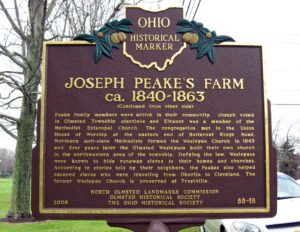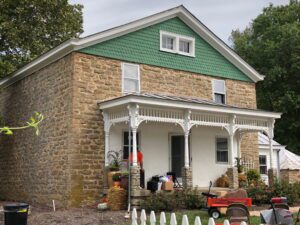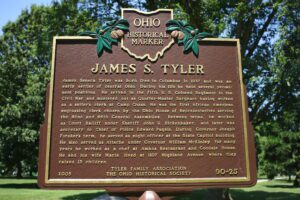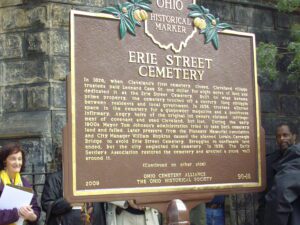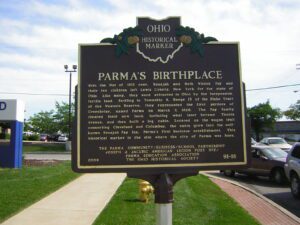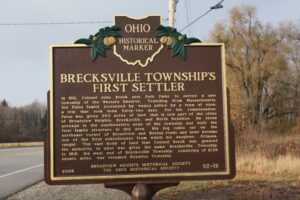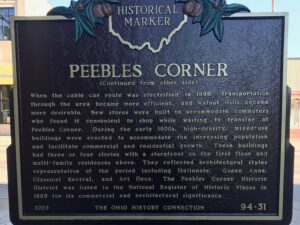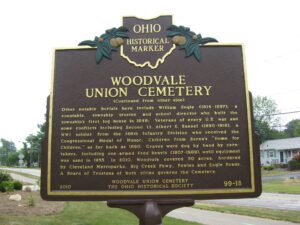, OH
Joseph Peake was born in Pennsylvania in 1792 and came to Ohio in 1809 with his parents and brother. They were the first African Americans to settle permanently in the Cleveland area. He was the son of George Peake, a runaway slave from Maryland, who fought on the British side at the Battle of Quebec in 1759 during the French and Indian War. A man with some means and talent, George Peake invented a stone hand mill for grinding corn, a labor-saving device that endeared the Peakes to their neighbors in western Cuyahoga County. Joseph Peake and his wife Eleanor, an African American from Delaware, bought land in the 1840s on the Mastick Plank Road and built a home near this marker. [Continued on other side]
, OH
The Clark Stone House, constructed around 1801 by James Clark (1765-1852), is one of the oldest standing stone houses in Ohio. Clark, who served as a drummer in the Battle of Yorktown (1781), came with his family to Anderson Township in 1797 and bought this land along Clough Creek. Clark was a mathematician, taught school, ran a distillery, operated an orchard nursery and served as a justice of the peace, a judge, and a state legislator. The two-story dressed limestone house was sold to the Leuser family in 1864, was acquired by the related Messmer family in 1923, and sold to Anderson Township in 1995.
, OH
James Seneca Tyler was born free in Columbus in 1837 and was an early settler of central Ohio. During his life he held several prominent positions. He served in the Fifth U.S. Colored Regiment in the Civil War and mustered out as Quarter-Master Sergeant having worked as a sutler’s clerk at Camp Chase. He was the first African American engrossing clerk chosen by the Ohio House of Representatives serving the 62nd and 66th General Assemblies. Between terms, he worked as Court Bailiff under Sheriff John U. Rickenbaker, and later was secretary to Chief of Police Edward Pagels. During Governor Joseph Foraker’s term, he served as night officer at the State Capitol building. He also served as Attache under Governor William McKinley. For many years he worked as a chef at Ambos Restaurant and Goodale House. He and his wife Maria lived at 1107 Highland Avenue where they raised 13 children.
, OH
In 1826, when Cleveland’s first cemetery closed, Cleveland village trustees paid Leonard Case Sr. one dollar for eight acres of land and dedicated it as the Erie Street Cemetery. Built on what became prime property, the cemetery touched off a century long struggle between residents and local government. In 1836, trustees allotted space in the cemetery for a gunpowder magazine and a poorhouse infirmary. Angry heirs of the original lot owners claimed infringement of covenant and sued Cleveland, but lost. During the early 1900s Mayor Tom Johnson’s administration tried to take back cemetery land and failed. Later pressure from the Pioneers’ Memorial Association and City Manager William Hopkins caused the planned Lorain Carnegie Bridge to avoid Erie Street Cemetery. Struggles to confiscate land ended, but the city neglected the cemetery. In 1939, The Early Settler’s Association restored the cemetery and erected a stone wall around it. (continued on other side)
, OH
With the War of 1812 over, Benajah and Ruth Wilcox Fay and their ten children left Lewis County, New York for the state of Ohio. Like many, they were attracted to Ohio by the inexpensive, fertile land. Settling in Township 6, Range 13 of the Blake Tract of the Western Reserve, they represented the first settlers of Greenbriar, named Parma on March 7, 1826. The Fay family cleared their new land, including what later became Theota Avenue, and then built a log cabin. Located on the wagon trail connecting Cleveland and Columbus, the cabin grew into the well-known Benajah Fay Inn, Parma’s first business establishment. This historical marker is the site where the city of Parma was born.
, OH
In 1811, Colonel John Breck sent Seth Paine to survey a new township of the Western Reserve. Traveling from Massachusetts, the Paine family journeyed by wagon pulled by a team of oxen, a trip that took them forty-two days. For his compensation, Paine was given 200 acres of land that is now part of the cities of Broadview Heights, Brecksville, and North Royalton. He chose acreage in the southwestern area of the township and built the first family structure in this area. His log cabin sat on the northeast corner of Broadview and Boston roads and later became one of the first schoolhouses from which his daughter, Orianna, taught. The vast body of land that Colonel Breck was granted the authority to allot was given the name Brecksville Township. In 1818, the west end of Brecksville Township, consisting of 21.28 square miles, was renamed Royalton Township.
, OH
When the cable car route was electrified in 1898, transportation through the area became more efficient, and Walnut Hills became more desirable. New stores were built to accommodate commuters who found it convenient to shop while waiting to transfer at Peebles Corner. During the early 1900s, high-density, mixed-use buildings were erected to accommodate the increasing population and facilitate commercial and residential growth. These buildings had three or four stories with a storefront on the first floor and multi-family residences above. They reflected architectural styles representative of the period including Italianate, Queen Anne, Classical Revival, and Art Deco. The Peebles Corner Historic District was listed in the National Register of Historic Places in 1985 for its commercial and architectural significance.
, OH
Woodvale Cemetery was established in the mid-1800s, in Middleburgh Township, Ohio. The oldest marked grave holds Fred G. Klink (1835-1858), whose family donated a half acre of land for burials. In 1876, Frank M. Stearns (1832-1911) suggested the unnamed cemetery be called Woodvale, after the wooded vale beside it. In 1908, a fire destroyed the caretaker’s house and many cemetery records. Woodvale became a non-profit, union cemetery in 1931, owned by Berea and the Village of Middleburg Hts. and covering 35 acres at 7535 Engle Road. Pioneer families buried here: Fowles, Kraft, Lovejoy, Sprague, and Stearns. Also buried here: John Baldwin (1799-1884) founder of Baldwin University and James Wallace (1878-1953) founder of German Wallace College (merged in 1913 to become Baldwin Wallace College) (Continued other side)


